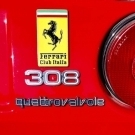What are the best advices you could receive to buy your Ferrari 308 or 328 ? Without any doubt, it would be advices from owners who could tell you about their experience. After reviewing all the versions of the Ferrari 308 and 328, and then their cosmetic aspects, in the two previous articles, TripleBlack®, Speedy, Sebino, Yves and ScuderiaCH will now give you their buying advices. You will learn what to look for on each model, their known issues, and you will get a check-list to use when looking at an interesting copy.
A. General and numbers
Ferrari 308s are reliable cars with reasonable maintenance costs for this brand if maintenance is performed correctly and according to the period manufacturer's recommendations. In all cases, priority should be given to a car with a clear history that can trace its maintenance history for the past 10 years at least. Then, it will be possible to appreciate whether the maintenance has been thoroughly done or not because for a car that is now more than 30 years old, some restoration can be expected to have taken place on most of the car unless you find a model in an exemplary condition. Such cars do exist but are becoming increasingly scarce, furthermore, paint on fiberglass bodies is reputed not to age very well. If this might be hoped to be cosmetically, caution must be exercised for the engine and all undercarriage parts: seals and bushings do not have an infinite life. Life begins at 30 ? Yes, but not for rubber !
If the car still has its warranty book, the chassis’ number is written on the first page; it is also engraved on the rear right side of the engine compartment, on the nameplate at the same location and also on the top of the steering wheel column. On most Ferrari 328 (except the very first cars), it is further repeated in etching on the windows of the car, followed by three letters.
Engine and chassis numbers are not related. Given today’s communication policy of Ferrari SpA, it is difficult to ascertain if this is the original engine mounted in this frame by the factory or not.
There is also another number generally stamped on the oil cooler bracket on the left of the engine compartment, which indicates the order of assembly, or « Assembly number ». It shows specifically the car's order in the production line and this position is not strictly linked to its chassis numbers, especially at the time of the fiberglass / steel transition.
B. Ferrari 308 GTB/S and 308 GT4
B.1. Known issues of the Ferrari 308 GTB/S
Engine : The engine is generally reliable when proper maintenance can be ascertained. It is customary to replace the timing belts and tensioner bearings according to the manufacturer's recommendations. It is a simple and inexpensive operation (it is not necessary to remove the engine for this on this model) compared to the damage that may occur should they break. Two-valve engines have exhaust valves filled with sodium to dissipate heat. As they age, we read that they can sometimes get brittle, but it seems very rare. Valve guides wear may occur sometime; this seems due to unleaded gasoline use resulting in excessive oil use. This is a strong engine the difference between the least powerful of the 308 and 328 is only 25%, therefore the engine has development potential. The most common change in search for more power is to increase capacity to 3.4 litre, reworking bore and stroke, with new pistons and a 360 crank, with more specific camshafts. In conclusion, when researching a future car, it is advised to look for an engine that has been regularly run (long immobilization can be very expensive) and has been adequately maintained. Frame : The carrier trellis, made up of large tubes is very strong and resists corrosion. A review on a lift will allow detection of major repairs consecutive to an accident. Anyway, during the road test, you have to be careful (and suspicious!) of any path deviation. Many first generation models were « upgraded » with 16" wheels instead of their regular 14” equipment. Aesthetically, it's not bad but finding a set of 14" wheels is not simple, and in any case expensive.
Electricity : There, the picture is less funny, especially on carbureted cars ! It's Italian, old time ... that said, although annoying, these problems are usually not very expensive in their consequences (many peripheral elements come from the Fiat organ bank !). Note mainly (but small « fantasies » are innumerable): the power windows have motors that are not powerful enough and mounted with cables and pulleys. It is necessary to clean the old grease, often hardened with time, with a solvent, and replace it with lithium grease. We see the same problem with the engine wiper. Some replace fuse boxes with aftermarket parts that have a reputation of giving the system more performance. The advantage is that this is completely reversible. The lighting is "confidential". Should you really need at night, a small change with introduction of relays and taking the power more directly from the battery greatly improves things. In addition, this reduces the wear on the stalk which in this case, only serves to control the relay. Here too, the operation is completely reversible.
Clutch : Before the change of the clutch mechanism in 1980, the clutch is reputed to be very stiff and tiring. However, it is relatively robust and it is not uncommon to do 30 000 Miles before replacement.
Transmission : The gearbox is deemed to be reluctant to accept the 2nd gear when cold. There is no known real improvement available other than using a more suitable oil. The « o » ring seal on the shift shaft leak over time and the engine oil can flow into the gearbox. This causes an oil quantity above the recommended level which is easy to identify. Better rings can then be mounted to prevent new problem.
Cooling : Cooling may seem inadequate, but problems often result from poor maintenance. Especially on low-mileage cars, pipes had ample time for clogging. Replacement costs little ( piping by the meter, with the exception of a right angle at the radiator entrance). Check the radiator core, fans, thermostat, thermal switch and bleed the circuit. With the engine in the rear and radiator in the front, and the difference in height minimal, bleeding is not easy: the system must be bleeded at both ends. And this is not possible on the first engines that have no bleed valve on the thermostat. The water pump should be monitored regularly; it is fragile on these models.
Air Conditioning : Air Conditioning is designed for Freon (R-12) which is no longer available, but some owners convert to R134a. This is a less efficient fluid, but the charge is cheaper. Substittution by a Sanden compressor, more effective than the original Aspera is possible (some say the Aspera is incompatible with the R134). Suspension : Original rubber suspension bushings and dampers must be changed every 50 000km. Check if cracked or chipped. This is a very common problem.
Ignition : The first cars have points ignition and electronic ignition appeared during 1977.
Body : The steel on the carbed 308 was not rust-proofed therefore monitor the apparition of rust at the bottom of the doors (lower external and internal part at the joint), on the lower body notably behind the wheel arches. The doors can also rust inside (including on the fiberglass cars whose inner door frame is made of steel) due to a sealing of the window not very tight and water may collect in the bottom of the door if the drain holes are blocked. At the bottom of the windshield where water stagnates, at the junction of the sail panel and the rear wing, under the rear license plate and along the beltline gutter. Since 1981, the sheets are galvanized and treatment improves further in 1984. Roof Seals on GTS.
Interior and tools : The interior materials are generally of average quality and finish. Imitation leather dashboard is often a bit « cooked » by the heat in the cabin in the summer and often has cracks (or more). Make sure the car is complete with all its period accessories, spare wheel (« pancake » spare wheel badged « Dino » on European 308, standard full size wheel on exports), jack (3 parts), tool kit (including 14mm spark plug tool), gauges, lights, emergency lamp, emergency crank windows, owner’s pouch with manuals. For GTS, roof cover. Check the long zip on the vinyl boot cover that protects luggage and the one on the spare wheel cover.
B.2. Specific points to watch the Ferrari 308 GT4
Some parts have become very hard to find such as lights, metal bands around the bumpers, the polyester molding that supports the fiber shroud under the bonnet which supports the spare wheel. Do prefer a car with intact door panels, as these were often cut to put loudspeakers.
B.3. Customers changes on Ferrari 308
- Aftermarket fusebox.
- 328 water pump.
- Aluminum toothed wheel for timing belts.
- Exhaust, headers (originally stainless steel) and silencer (originally stainless steel).
- 16" wheel for the carbureted 308 .
- Racing brakes and calipers (only for 16" wheels).
- Electronic injection changed to MSD or Electromotive type.
- Larger diameter rear anti-roll bar.
- Changing the heater fans from the back of the radiator.
- Windows accelerators.
C. Ferrari 328
C.1. Known issues on the Ferrari 328
Engine : The engine of the 328 is robust, and if the maintenance was carried out according to the factory recommendation, it should reach 100 000 Miles before requiring reconstruction. Oil consumption should be monitored; it should not be above the manufacturer's recommendations; the engine block should be inspected for leaks. The K-Jetronic Bosch injection is generally reliable if the circuit is clean and not clogged with impurities (a risk with cars stopped for a long time with their fuel in their tanks, which may decompose). Exhaust manifolds can crack or break, they should be inspected from time to time. If looking for a car, it would be, as usually preferable to choose a car with an engine that has been run regularly. A car that has just been re-started after a long sleep may appear capricious.
In conclusion, during the search of a vehicle, cars with an engine that has been regularly run should be favored (long immobilization can be very expensive) and has been well maintained.
Ignition : The leads and extensions have to be checked to avoid « hot spots », burns (blackened extensions). Some 328 can be moisture sensitive.
Clutch : It is relatively robust, the change occurs in principle « about 40 000 Miles ».
Transmission : The box is deemed reluctant to engage the 2nd gear when cold, although it may depend form car to car, the second gear should not be engaged by force as long as the gearbox oil is cold this will destroy the synchros; go from first directly to third if the gearbox oil is not hot. There is no known real improvement available other than using a more suitable oil.
Cooling : Cooling of the 328 has been improved compared to its cousins / predecessors, and whatever the traffic conditions, a healthy 328 does not heat at all. The cooling circuit is notoriously difficult to bleed fully, as « air pockets » or « bubbles » form in the high points; this can cause coolant « spurts » through the overflow tube of the expansion tank. It is always advised before bleeding the coolant circuit, and after completing coolant, or when retrieving the car after revision, to run the first few tens kilometers with the heater circuit fully open, because this « parallel circuit » often retains air pockets. The water pump must be monitored regularly because it is fragile on these cars.
Air Conditioning : Air conditioning is generally marginal on these cars; it was also originally designed for Freon or R-12 which is now prohibited; adaptation to R134a is usually less effective in providing cold air, and the hoses originally designed for R-12 are not perfectly sealed to the smaller R-134a molecules. In contrast, as the car produces large quantities of hot air, in winter heating is very effective.
Efficient use of the windows and windshield defrost through hot air, however, requires some practise.
Suspension : Original rubber suspension bushings and dampers must be changed every 30 000 Miles. Check if cracked or chipped. This is a very common problem.
Body : The first 328s left the production chain a year and a half after adoption of the « Zincrox » rust-proofing process; their steel panels are therefore protected against corrosion; this does not preclude that some points should be monitored, as the folded « lip » around the semi-circle of the wheel arch in the fenders. As for the 308, water may tend to accumulate in the doors; make sure that the two drain holes in the bottom of each door are open (thereby also check for the presence of the door seal, frequently absent or sagging).
Electricity : The electrical system is not generally the highlight of a Ferrari from this period, but that of the 328 is « relatively satisfactory »; power windows are not very fast, but motivate less complaints than 308.
However, it must:
- Check the control stalks for headlights and wipers: not only should these be fully functional make sure there are not too « loose » with too much play and that the bakelite not turn freely on the stalk.
- Check electric mirrors servomotors; note that new switches are very difficult to find; check the operation of all electrical controls in the center console and in particular the illumination of the
« LEDs » for ventilation and heating.
- It is essential to check very closely and with great care both front fog lights (the two optical blocks that are at the left and right of the front grill and serve as flashing lights) and make sure they are not broken or cracked, as these fog light are now very difficult to find and therefore very expensive to replace.
Interior and tools : Make sure the car is complete: with spare wheel (« pancake » on European cars, full size wheel on some exports), its hold-down bolt; the jack kit (3 parts), including the small magnetic lamp, tool roll (including the 14mm combination wrench to fit the 12mm spark plug wrench (and not 14mm plug as for 308) , gauges, lights, owner’s pouch with manuals. For GTS, roof cover. Check the large zippered canvas that protects the luggage compartment and its long zipper.
C.2. Customers changes on Ferrari 328
- Exhaust, manifolds (originally stainless steel) and silencer (originally stainless steel).
- Wheel 17" and 18" from Compomotive, depending on the suspension (series1 / series2).
- Carburetors kits for nostalgic.
- Transparent roof for GTS called Saratoga Top.
D. Checklist for your visit
Checking the numbers
- Chassis number (is the one on the right rear engine strut identical to the one on the steering column plate ?) :
- Engine number :
- Paint color label in the middle of the rear hood for carburetors car, near licence plate light for later 308 :
Checking the dates
- Last belt replacement (particularly timing belts) :
- Last oil replacement, spark plugs change:
- Geometry adjustment:
- Full service history, invoices :
- Consistency between warranty card/ maintenance bills / Odometer :
Interior control
- Headliner top :
- Imitation leather of the dashboard :
- Floor Mats and rear bulkhead (lifting carpets) :
- Seats :
- Trunk and spare tire (early models) cover zips :
- Rubber on doors and windows (supple and not damaged ?) :
- Comprehensive test of all electrics (especially power windows and headlights pods) :
- Test the air conditioning :
- Check the fuse table :
- Check seat belts :
- Antenna on the rear right fender and pre radio fittings :
- Spare wheel :
- Tools within the two kits :
- Tool roll: carburetor key, set of 8 wrenches (6 to 22) pliers (180 mm), screwdriver (120 mm), screwdriver (150 mm), Phillips screwdriver (4 mm) Phillips screwdriver (5.9 mm), spark plugs wrench :
- Jack bag: Yellow jack parallelogram jack, alternator belt, compressor belt AC, warning triangle, set of fuses, set of light bulbs, 2 spark plugs :
- Emergency crank (windows) :
- Emergency light :
- Key locking doors :
- Opening of the hoods :
- Shock traces inside the front hood :
- Oil in Water :
- Water in oil :
Control from outside
- Alignment of the doors :
- Check the wear on door hinges, their frictionless operation :
- Verification of the opening of front and rear hood. Ensure that the main system and the backup work both (each hood has a backup loop / handle in case the main cable breaks; these loops are under the left edge of the dashboard for the front hood and behind the upper part of the driver's seat belt for the rear one) :
- Inspection of the body in search of rust bubbles (doors, rocker panels, waistline, under the seal of the windshield, around the front hood where aluminum is mounted on a steel frame, even on the fiberglass cars) :
- Is the car still in original paint or not :
- Wheels: check the condition of the rims, scratches, bumps, etc… as some are hard to find and therefore expensive :
- Wheel bolts, look carefully if they are bitten by rust, or if the chromium is not chipped; if it is, it will be changed, which means finding a new set (expensive, especially as original parts) or used (rare) or have them re-chromed :
- Tires (check symmetrical wear ?) :
- Scratch on the windows :
- Inspection of rubber :
- Badges :
Control the underside
- Signs of re-painting, beware of a chassis that has been supposedly treated and protected, it can hide a major repair :
- Check corrosion on the door sills and wheel arches :
- Drips of oil, water, brake fluid (check calipers), oil loss from the shock absorbers :
- Control the front and rear “cradles” of the chassis: Accident symptoms: welding of tubes :
- Shock absorbers + running gear: rubber seals control of the ball joints / joints :
- Play in the wheels :
- Brake discs condition:
- Exhaust :
- Water hoses :
- Leaks of the water pump :
Checking the engine bay
- State of all hoses :
- Check the play and the condition of belts :
- Check for signs of leaks on the water box :
- Check for leaks on the radiator (front hood) :
- Engine cleanliness, especially between the carburetors ramps :
Driving
- Before starting, check that the oil lamp lights at starting (on models that have one) and control of the generator :
- Can all the gears be easily engaged without hearing crunches : - Start, cut and easy re-start :
- Test the parking brake (usually not very effective) :
- Operation of the fuel gauge :
- Smoke at startup :
- Hot Smoke :
- Idling stability :
- Do brake and clutch pedals after being depressed return to their level before release :
- Second gear synchro usually reluctant, especially in the cold :
- Course and noise of the clutch :
- Does the car dart left or right spontaneously :
- Braking behavior :
- Make two loops 360° on each side and pay attention to any unusual noises :
- Driving along a wall, note the unusual noises :
- Steering play (dead center ?) :
- At a 80 MpH speed, the engine has to run without a hitch :
- Check noise and vibration when freewheeling :
- Oil pressure >= 6 bar at 5000 rpm :
- White smoke when accelerating (a little brown smoke is normal) :
- Operation of fans (starting and shutdown) :
- Check exhaust smell, oil smell or coolant smell after driving :
Conclusion
You now have in your hands, with those 3 articles, a good amount of knowledge coming directly from the Ferrari 38 and 308 owners to help you reduce the risks when chossing your exemplar. A BIG THANK YOU goes to TripleBack®, Speedy, Yves and ScuderiaCH for these articles !
For what other question would you like a reply, in order to help you choose your Ferrari 308 or 328 ? If you're already an owner, what advices would you add ?
If you liked this article, you might also like reading:
- Ferrari 308 and 328 buying guide : the cosmetic aspects (2/3)
- Ferrari 308 and 328 buying guide : the various versions (1/3)
- The dedicated website with the full Ferrari 308 and 328 buying guide












Il n’y a aucun commentaire à afficher.
Rejoindre la conversation
Vous pouvez publier maintenant et vous inscrire plus tard. Si vous avez un compte, connectez-vous maintenant pour publier avec votre compte.